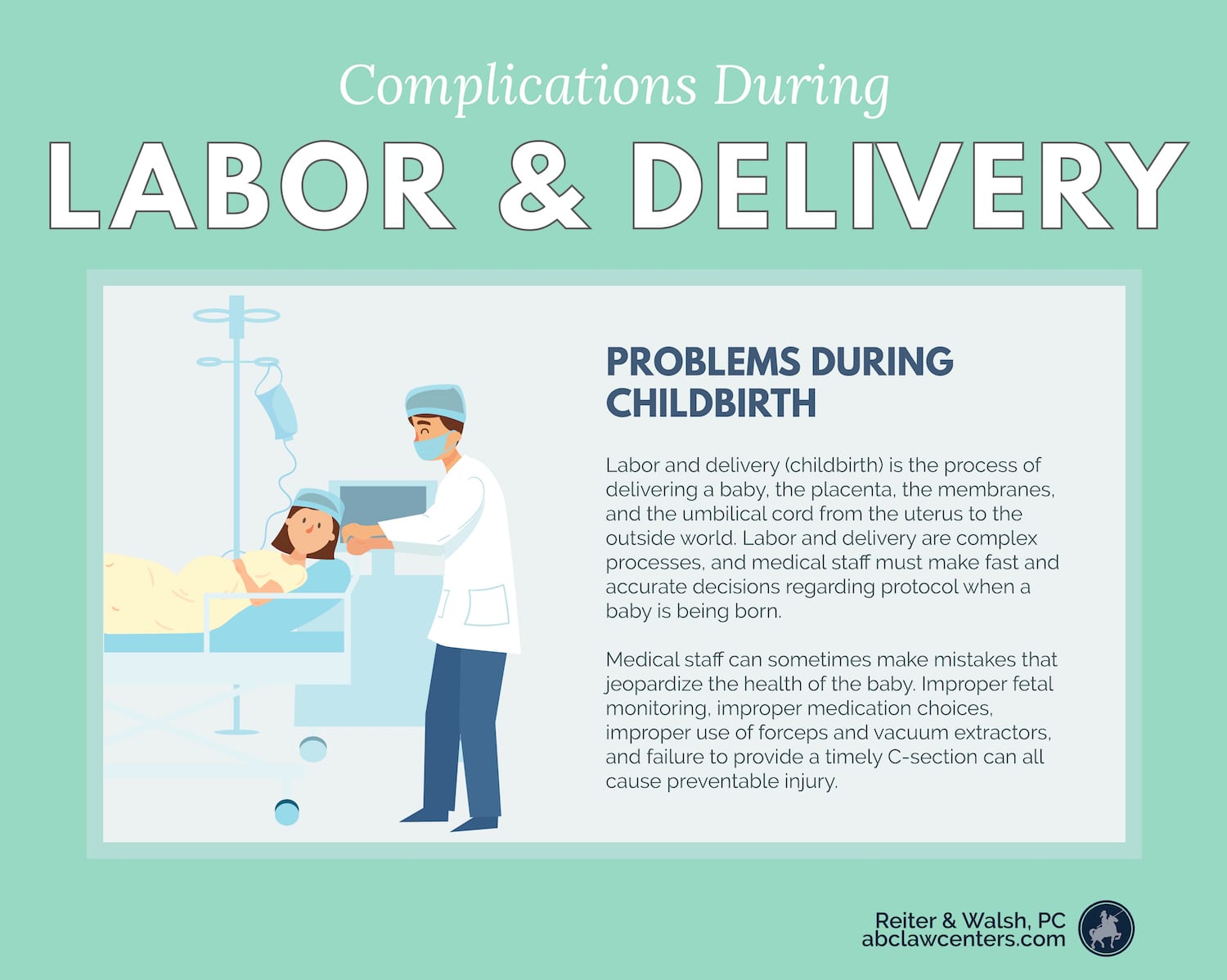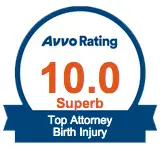Labor and Delivery Complications and Errors
The process of labor and delivery is very complex, and medical staff must make fast and accurate decisions. Doctors and nurses sometimes make mistakes that jeopardize the health of the mother and/or baby. Some of the most common causes of preventable harm include improper fetal monitoring, medication mismanagement, poor communication, unrecognized fetal distress, incorrect use of forceps and vacuum extractors, and failing to perform a C-section in time.

Common labor and delivery complications
Often, women are able to give birth without any issues. However, there are significant risks associated with labor and delivery, and labor and delivery complications can be very dangerous without proper medical intervention. It is considered medical malpractice when mother or baby suffer preventable injuries. Attorneys investigate if a baby is harmed by negligent actions during labor and delivery.
Below is information on specific types and causes of birth injuries. Follow the links for more information, including how malpractice may play a role.
Birth Asphyxia
Birth asphyxia, or oxygen deprivation around the time of birth, is a common cause of infant brain damage. If a baby does not have enough oxygen in their blood, or if blood flow to the brain is restricted, they may be born with a serious birth injury called hypoxic-ischemic encephalopathy (HIE). HIE can cause permanent brain damage, cerebral palsy (CP), seizure disorders, and/or intellectual or developmental disabilities. Read more.
Delayed Emergency C-Section
In high-risk situations, delivery must take place immediately to prevent harm to mother and baby. These circumstances call for an emergency C-section, which must take place in 30 minutes or less. In some cases, an emergency C-section should take place within 10-18 minutes in order to protect the baby from irreversible damage. If an emergency C-section takes too long to perform or if doctors prolong labor for longer than what is reasonable, a baby can suffer a brain injury from not getting enough oxygen. Read more.
Forceps & Vacuum Extractors
Doctors may use forceps or vacuum extractors to help guide the baby down the birth canal during a strained or stalled vaginal birth. This procedure is called an assisted delivery. However, there are very strict standards for when and how to use these instruments. Improper use can injure the baby, and put them at high risk for brain bleeds. Read more.
Improper Fetal Monitoring
Fetal heart monitoring is the best way for medical professionals to tell if a baby is getting enough oxygen. If the baby’s heart rate is too high (tachycardia), too low (bradycardia), or otherwise abnormal, this is a sign of fetal distress and must be immediately addressed. If medical professionals fail to use or use monitors incorrectly, misinterpret monitor readings, or fail to intervene when necessary, the consequences to the baby could be serious. Read more.
Medication Errors
Some of the most commonly-administered medications during childbirth, such as Cytotec and Pitocin, are associated with significant complications for both the mother and baby. It is critical that medical professionals carefully explain the potential risks and benefits and obtain the mother’s informed consent. Read more.
Placental Abruption
Under normal circumstances, the placenta is attached to the uterine wall, providing the baby with nutrients and oxygen, as well as removing fetal waste products. It is usually expelled naturally after the baby is delivered as part of the afterbirth. Placental abruption happens when the placenta separates prematurely from the uterine wall. This can cause dangerous maternal and fetal hemorrhaging, as well as oxygen deprivation to the baby and consequent fetal injury or death. Read more.
Placenta Previa
Placenta previa is a condition in which the placenta lies unusually low in the uterus, where it partially or completely covers the mother’s cervix and may block the baby’s passage out of the womb. When diagnosed early in pregnancy, placenta previa may not be a serious problem and resolve on its own. However, placenta previa in the third trimester can lead to life-threatening hemorrhagic bleeding in the mother and birth injuries such as hypoxic-ischemic encephalopathy (HIE) in the baby where delivery does not occur by C-section in time. Read more.
Traumatic Birth Injuries
Traumatic birth injury (birth trauma) is a subset of birth injury caused by physical pressure during labor and delivery that specifically impacts the baby’s brain. Birth trauma is often caused by mechanical force, but it can also be caused by the overuse of delivery drugs, mismanaged abnormal presentation, and other complications. It may also occur with or complicate hypoxic-ischemic encephalopathy (HIE). Read more.
Umbilical Cord Injuries
The umbilical cord connects the mother to her unborn baby and provides the baby with oxygen and nutrients, as well as waste removal. Complications involving the umbilical cord may lead to birth asphyxia, which in turn can lead to serious birth injuries such as hypoxic-ischemic encephalopathy (HIE) or cerebral palsy (CP). Umbilical cord issues can include: compression, nuchal cord, true knot, prolapse, short cord, vasa previa, or intrauterine infections or chorioamnionitis. Read more.
Uterine Rupture
Uterine rupture occurs when there is a tear in the uterus resulting from pressure during pregnancy, labor, or delivery, The uterus can rupture through some or all of its layers, compromising the fetus’ oxygen supply and causing severe bleeding in the mother. Uterine rupture often causes the baby to move into the mother’s abdomen. Read more.


Legal help for children with birth injuries
Birth injury cases are complex, both medically and legally. For the best case outcome for your child, it’s critical to find an attorney and a law firm that focus specifically on birth injury cases. At ABC Law Centers (Reiter & Walsh, P.C.), our attorneys have focused their entire careers on this area of law, and they consistently secure multi-million dollar settlements for our clients.
Contact us today to begin your free case review. We will answer your questions, help you understand where malpractice may have occurred in your child’s case, determine the negligent party, and inform you of your legal options. Moreover, you pay nothing throughout the entire legal process unless we win or favorably settle your case.
- Free Case Review
- Available 24/7
- No Fee Unless We Win
Featured Videos
Posterior Position
Hypoxic-Ischemic Encephalopathy (HIE)

Featured Testimonial
What Our
Clients Say…
After the traumatic birth of my son, I was left confused, afraid, and seeking answers. We needed someone we could trust and depend on. ABC Law Centers was just that.
- Michael






















